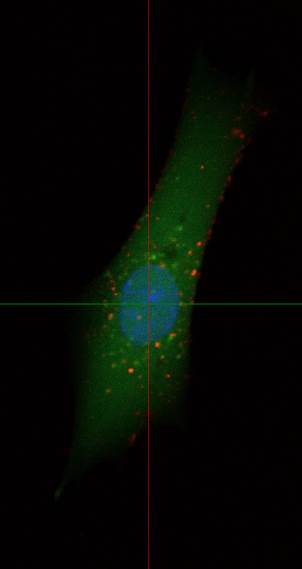Research
My research group is broadly interested in biomolecular interactions. Our major project is development of novel cell-penetrating peptides for delivery of biomolecular cargos to living cells for therapeutic and research purposes. For years, I worked on developing a better understanding of assembly of the bacterial flagellum. We also engage in many collaborative projects in which we can bring our optical biosensing and other kinetic expertise to bear on a variety of research questions. See publications for details; I don't know why but KSU's library folks love it when you use my Digital Commons page.
1. Cell-penetrating peptide adaptors 
Cell-penetrating peptides (CPPs) confer the ability of molecules to which they are attached the ability to enter cells rapidly and without discernible toxicity. They have been used to deliver proteins and other 'cargo' molecules to cells for years, but have many drawbacks as therapeutic vehicles, principally the so-called 'endosomal escape problem' - they succeed in penetrating the cell by endocytosis but get hung up in the endosomes. We have a really cool solution to this problem and are actively developing applications and engineering better CPPs.
This work is currently funded by an NIH AREA grant.
2. Application development for CPPs
We have several projects underway, which can't be described here because of intellectual property concerns (they could be worth billions of dollars, bwa ha ha!), wherein we are developing potential therapeutic applications for our patented CPP-adaptors. See our recent cervical cancer paper for an example. These projects are suitable for students interested in pursuing molecular pharmacology, biomedical or biotechnology careers after KSU.
3. Biosensor applications
I am also interested in broad applications of biosensor technologies. My lab has optical biosensing platforms: two ForteBio biolayer interferometers, a classic Octet QK and it's modern cousin, an Octet Red. They are capable of analyzing biomolecular interactions in real-time. We also have a TA Instruments NanoITC. We are actively pursuing several avenues including quantitation of small molecules in complex solutions and occasionally have collaborative projects with investigators at KSU and other institutions around the world.
If you have a binding problem... if no one else can help... and if you can find me... maybe you can hire... me. (Just kidding! Despite many youthful fantasies, I've never actually been part of the A-Team.) My team collaborates on numerous projects in exchange for nothing more than a small share of the fame, the thrill of discovery and just because we like doing it. Please contact me to discuss your biosensing project.









